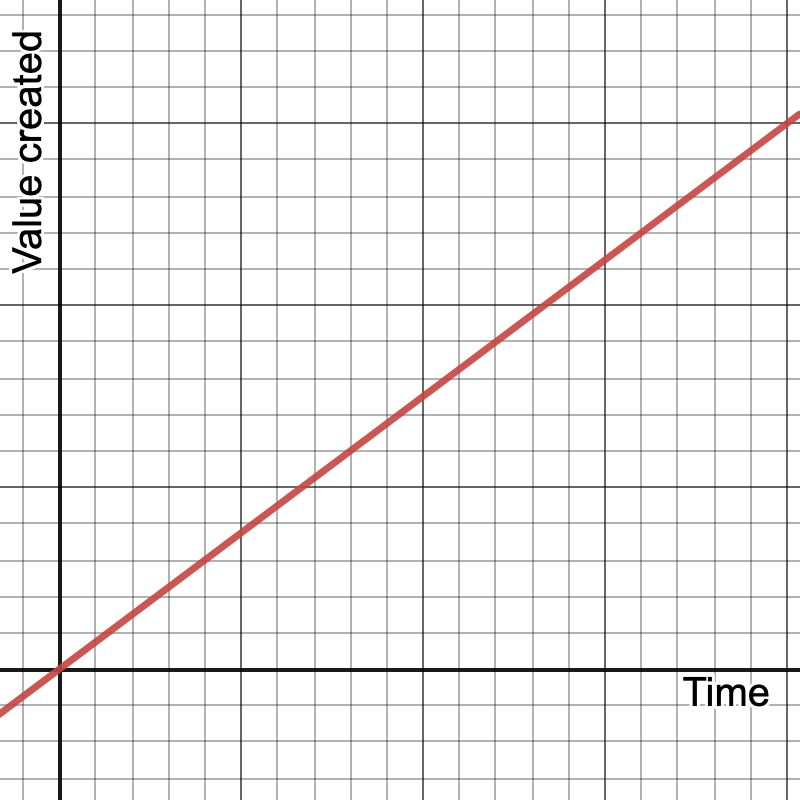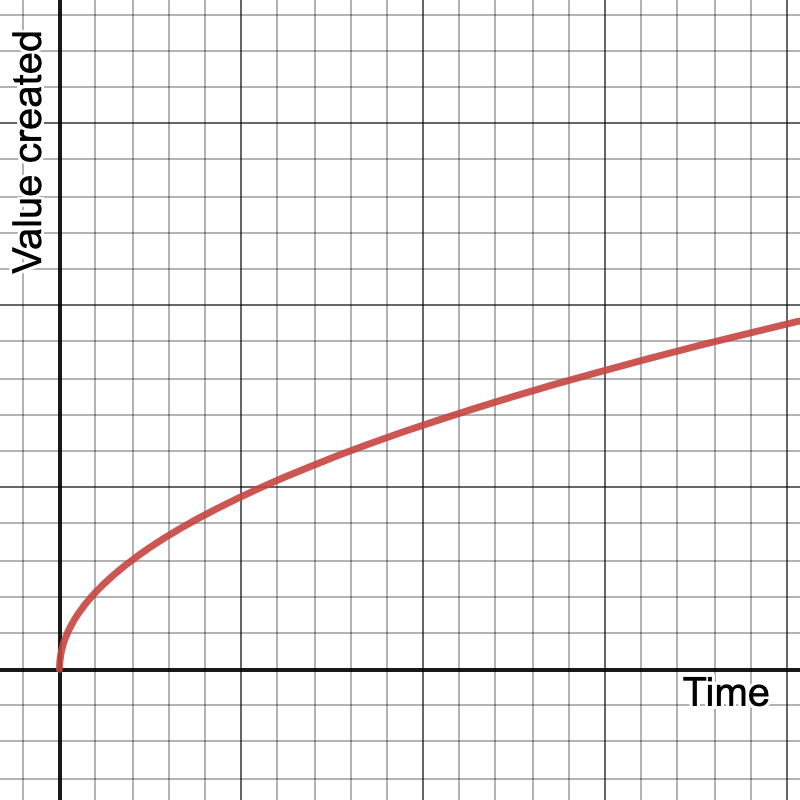We are constantly and unknowingly catching buses and that's a good thing
Published on 18-Jul-2021 -- Last updated on 18-Jul-2021
Every day, everyone has to decide what to do with their time. Do we reserve time to relax or reflect? Some extra time studying or working? Some time for that hobby project you have been putting of for weeks, if not months now? We are constantly making and adjusting plans, both consciously and subconsciously. A lot of us are constantly looking to squeeze out as much of our time as possible. Probably, we want to spend time on items we deem important, which can include relaxation but also studying a new skill. It seems only natural that we analyze what effect the investment of our hours actually offers in return. I want to have a look at one of the patterns which keeps coming back in these analyses, why rarely noticing it can cause problems and what we can learn from noticing it. I am going to start of with when I first noticed this pattern and what effect that had on me.
Speedrunners & Buses
Every so often I find something which completely absorbs me. A few years ago, this turned out to be speedrunning. The act of completing certain tasks as fast as possible may seem mundane to some. But over the last years, this has become particularly prevalent in the video gaming community. It turns out that speedrunning shows many parallels to how we conduct ourselves in our everyday lives. One often has to go to the extremes to draw lessons about the modest. What I found especially intriguing is the combination of skill, exceptional problem-solving and the presence of chance which is so commonplace within this community of speedrunners. Sometimes people go to remarkable lengths to shave of an extra hundredth of a second.
At the time, I was interested in the speedrunning world record for the old Super Mario Bros game and all the tricks and computer glitches in the game's code some individual had used to set a record. As this person would explain, it was impossible to get a record one hundredth of a second faster than him. Similarly, he was unable to be one hundredth of a second faster than the previous record. It turned out that, as can be seen in Figure 1, that you could only finish every level every ~0.35 seconds. Let us assume that it is exactly 0.35 seconds. This means it will not matter if you finish a level in 17.51 seconds or in 17.84 seconds because you would start the next level at the same time. This might not seem like a big deal, but to speedrunners — to which every millisecond is a massive deal — this was a giant hurdle to cross. Similarly, if you finish the level in 17.49 seconds instead of 17.51 seconds, you would actually not gain 20 milliseconds but 350 milliseconds.

So, what is actually going on here? The game draws roughly 60 pictures (also known as frames) on the screen per second, which we will perceive a smooth video (game). Every 21 frames — which over ~60 frames every second roughly equals 0.35 seconds — the game will determine whether we have finished the level at that point. Depending on whether we have then finished the level, it will decide whether to start the procedure to move onto the next level. This is analogous to a bus stopping at the end of the level every 21 frames: ready to take you to the next level. I am very much not the first one to make use of this analogy. The original speedrunner even talked about catching the bus. Whilst real-world buses might not arrive every few milliseconds, we might also not be looking to save milliseconds. It turns out that this pattern between time and value created is quite common.
Time patterns
When we look at how we might use our time, there are many flavors of relationships between used time and the value of our time investment. We can have a linear relationship: the more time we invest, the more value we might create. This can for example be having a ‘clocking-in clocking-out’ job, where you clock in when you start working and clock out when you stop working. Here, if you work 5 minutes, you will earn 5 times as much as working 1 minute. This can be seen in Figure 2. Another relationship — in fact one of the most common relationships — is diminishing returns. A term borrowed from economics, which in essence comes down to “the more time you invest, the harder it becomes to gain value”. It can be seen as you over time getting tired. Similarly, one of the best examples is the value of your work over time whilst you are getting tired. A graphical representation can be seen in Figure 3. There are many others of these patterns.


One of the patterns which closely resembles how the Mario game before handles time has no definite name. Since it shows up in many fields in different ways, it is also known under different names. Most of the time, it involves words as “clustering” or “interval”, but I would like to refer to it as the “Bus Stop Pattern”. So, what am I talking about? Imagine we are observing a bus stop where many people are constantly arriving and taking the bus. As can be seen in Figure 4. If a bus leaves from the bus stop every 15 minutes, you might have to wait anywhere from say 0 second, if you arrive just as the bus arrives, to 14 minutes and 59 seconds, if you just missed the bus. But if you just missed the bus by a few seconds, you will have to wait until the same point in time as someone who missed the bus by 5 minutes. Making missing the bus by 1 second have an equal cost of time as missing the bus by 5 minutes. If fact, one might argue that the person who missed the bus by 5 minutes is potentially better off (time-wise). Similarly, one might argue the same for someone who missed the bus by 10 minutes or a person who caught the bus by 1 second. In the real-world scenario of this idealized problem, buses don't arrive and leave exactly every 15 minutes, but the idea still holds.

This pattern shows up a lot in everyday life. Other examples in traffic include traffic lights and slow-moving vehicles passing each other on the highway. But, it will also appear when forming schedules, when signing up for annual events, when talking to people, many areas of computer science, and many, many more occasions. Just being aware of when this pattern happens to you can save you time. If you know you are going to miss the bus, don't rush to the bus stop just to wait there for 15 minutes. Instead, you might clean out the dishwasher then rush to the bus stop. If you see that you will not make it for the next interval or even that you might not make it at all, it might be better to consider doing a different task. Most of the time, these will be short mindless tasks which you have either been putting off or you had planned for later. In both cases, you are saving time as opposed to waiting at the bus-stop, or at least not losing time to what might have been an unfortunate situation.
Forming your own bus stops
Being aware of the bus stops around you is very useful. It can save you time, money, and effort. What is even more powerful, however, is forming your own bus stops. One of the biggest problems we are dealing with in current-day life is context switching. Context switching is shifting from one task to another one which costs us time and a massive amount of mental effort. Similar to how players might warm up for a sports match. For some tasks, it might take upwards of 30 minutes to get into an optimal working state. This optimal state being sometimes referred to as the “flow” state, which was coined in the best-selling book Flow: The Psychology of Optimal Experience by Mihaly Csikszentmihalyi. The cost of switching is especially prevalent for tasks which require a more birds-eyed view. These tasks include, but are not limited to, reading books with many characters or different story-lines, studying academic subjects but also just whilst working most of the time. If we are looking to use our time optimally or even looking to expend the least amount of effort, it would seem logical to minimize the times we are context switching.
Most people know that there is a delicate balance between working time and break time. If you work too much without taking a break, you will eventually cause more problems within the work you are doing than you are solving in the same time. Similarly, there is this delicate balance between working on different tasks. Work on too little tasks and you might be too inflexible or cause annoyances with colleagues. Work on too many tasks and you might get nothing done, since most of your time and effort is spent context switching.
Even if you are not looking to optimize time usage, there is a still a big chance you want to avoid expending unnecessary effort on any individual task. That is where interrupt coalescing comes in. A term originally from computer science coined for day to day use by the book Algorithms to live by written by Brian Christian and Tom Griffiths. Interrupt coalescing is similar to introducing a bus stop for ourselves. If you get 5 emails every hour which we read and perhaps respond to, interrupt coalescing might tell us to maybe go through 30 emails every 6 hours. This method is like having a bus stop for your mail-inbox. If a certain email doesn't catch the bus now, the mail can catch the next bus in 6 hours. This leaves context switching to a minimum, getting more work done.
Some more extreme examples which are also discussed in Algorithms to live by show how this might be included in our day-to-day lives. Donald Knuth, who is one of the major players in computer science over the last century, works in a way he calls “batch processing”. He has many projects which he maintains. Projects over time are have grown large and unwieldy, if not for a complete deep dive into its subject matter. He will, therefore, intentionally work each of his projects for an extended amount of time — sometimes working solely on one project for months — only to ignore that same project for years to then repeat the cycle. This way, Knuth is completely intellectually entangled in a project for a couple of months before context switching to another task. Similarly, he doesn't have an email address, he reads and responds to his postal mail every 3 months and reads and responds to his faxes every 6 months. Whilst these specific measurements may not be applicable or even possible in your life, there are still lessons which can be drawn from his style of living. As said, we often have to go to the extremes to learn lessons about the modest.
There are many ways we might manage our time and effort. And for many people, minimizing time and/or effort spent on tasks is an (indirect) goal in our lives. If we are more aware of how prevalent “bus stops” are in our lives, this can help minimize time and effort expended. Similarly, if we actively search for opportunities to form these bus stops in our lives, we will minimize these factors even further so. Possibly, reducing stress and increasing the time and energy you have available for more important things. So slow down and catch the next bus and afterwards decide to spend a bit more time before you grab your next bus.